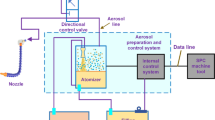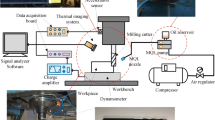Abstract
Minimum quantity lubrication (MQL) is the efficient and environmentally friendly technology, which is desirable to achieve sustainability during machining process. The nozzle distance has its significance in dominating the MQL spray and the related droplet transportation and penetration. In this paper, the nozzle distance has been optimized for MQL milling process through numerical and experimental methods. A two-way computational method has been employed to solve for the comprehensive flow field and particle trajectories, with the wall condition established on the spray impingement theory. The interactions of air flow rates and spindle rotational speeds on droplet penetration are investigated in details. The optimal ranges of nozzle distance setup obtained by simulation for different conditions were verified via slot milling tests, in which the nozzle distances were selected according to the key points obtained in the numerical process. The cutting force and surface roughness were recorded for the verification of adhesion ability and the related cutting performance. The comparison between numerical simulations and milling experiments has shown great consistency. This paper has achieved better understanding of the nozzle orientation setup and device development in MQL milling process, especially for external MQL. The theoretical basis and scientific instruction have been provided for the optimization of MQL operating parameters in industrial applications.
Similar content being viewed by others
References
Klocke F, Eisenblätter G (1997) Dry cutting. CIRP Ann 46:519–526. https://doi.org/10.1016/S0007-8506(07)60877-4
Iskandar Y, Tendolkar A, Attia MH, Hendrick P, Damir A, Diakodimitris C (2014) Flow visualization and characterization for optimized MQL machining of composites. CIRP Ann 63:77–80. https://doi.org/10.1016/j.cirp.2014.03.078
Leppert T (2012) Surface layer properties of AISI 316L steel when turning under dry and with minimum quantity lubrication conditions. Proc Inst Mech Eng B J Eng Manuf 226:617–631. https://doi.org/10.1177/0954405411429894
Zhang S, Li JF, Wang YW (2012) Tool life and cutting forces in end milling Inconel 718 under dry and minimum quantity cooling lubrication cutting conditions. J Clean Prod 32:81–87. https://doi.org/10.1016/j.jclepro.2012.03.014
Bhowmick S, Alpas AT (2011) The role of diamond-like carbon coated drills on minimum quantity lubrication drilling of magnesium alloys. Surf Coat Technol 205:5302–5311
Sanchez JA, Pombo I, Alberdi R, Izquierdo B, Ortega N, Plaza S, Martinez-Toledano J (2010) Machining evaluation of a hybrid MQL-CO2 grinding technology. J Clean Prod 18:1840–1849. https://doi.org/10.1016/j.jclepro.2010.07.002
Lawal SA, Choudhury IA, Nukman Y (2013) A critical assessment of lubrication techniques in machining processes: a case for minimum quantity lubrication using vegetable oil-based lubricant. J Clean Prod 41:210–221
Tawakoli T, Hadad MJ, Sadeghi MH (2010) Influence of oil mist parameters on minimum quantity lubrication–MQL grinding process. Int J Mach Tools Manuf 50:521–531. https://doi.org/10.1016/j.ijmachtools.2010.03.005
Mulyadi IH, Mativenga PT (2014) Random or intuitive nozzle position in high-speed milling using minimum quantity lubricant. Proc Inst Mech Eng B J Eng Manuf 228:21–30. https://doi.org/10.1177/0954405413495536
Hadad M, Sadeghi B (2013) Minimum quantity lubrication-MQL turning of AISI 4140 steel alloy. J Clean Prod 54:332–343. https://doi.org/10.1016/j.jclepro.2013.05.011
Masoudi S, Vafadar A, Hadad M, Jafarian F (2017) Experimental investigation into the effects of nozzle position, workpiece hardness, and tool type in MQL turning of AISI 1045 steel. Mater Manuf Process 33:1–9. https://doi.org/10.1080/10426914.2017.1401716
Yan L, Yuan S, Liu Q (2012) Influence of minimum quantity lubrication parameters on tool wear and surface roughness in milling of forged steel. Chin J Mech Eng 25:419–429. https://doi.org/10.3901/CJME.2012.03.419
Obikawa T, Asano Y, Kamata Y (2009) Computer fluid dynamics analysis for efficient spraying of oil mist in finish-turning of Inconel 718. Int J Mach Tools Manuf 49:971–978. https://doi.org/10.1016/j.ijmachtools.2009.06.002
Pervaiz S, Deiab I, Rashid A, Nicolescu M (2017) Minimal quantity cooling lubrication in turning of Ti6Al4V: influence on surface roughness, cutting force and tool wear. Proc Inst Mech Eng B J Eng Manuf 231:1542–1558. https://doi.org/10.1177/0954405415599946
Bai C, Gosman AD (1995) Development of methodology for spray impingement simulation[R].SAE Technical Paper
Stow CD, Hadfield MG (1981) An experimental investigation of fluid flow resulting from the impact of a water drop with an unyielding dry surface. Proc R Soc Lond A 373:419–441. https://doi.org/10.1098/rspa.1981.0002
Zhou M (1985) Fluid mechanics pump and air blower. China Architecture & Building Press, Beijing
Ashgriz N (2011) Handbook of atomization and sprays: theory and applications. Springer Science & Business Media, Berlin
Funding
This research is supported by National Natural Science Foundation of China (NSFC) under Grant No. 51475030. The authors are indebted to the financial support in the accomplishment of this research.
Author information
Authors and Affiliations
Corresponding author
Rights and permissions
About this article
Cite this article
Zhu, G., Yuan, S. & Chen, B. Numerical and experimental optimizations of nozzle distance in minimum quantity lubrication (MQL) milling process. Int J Adv Manuf Technol 101, 565–578 (2019). https://doi.org/10.1007/s00170-018-2928-3
Received:
Accepted:
Published:
Issue Date:
DOI: https://doi.org/10.1007/s00170-018-2928-3




